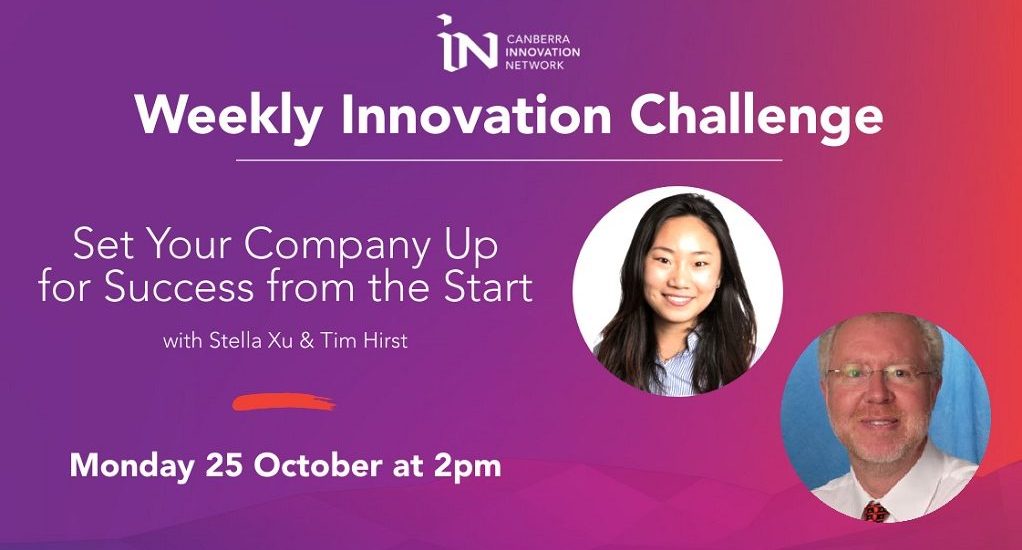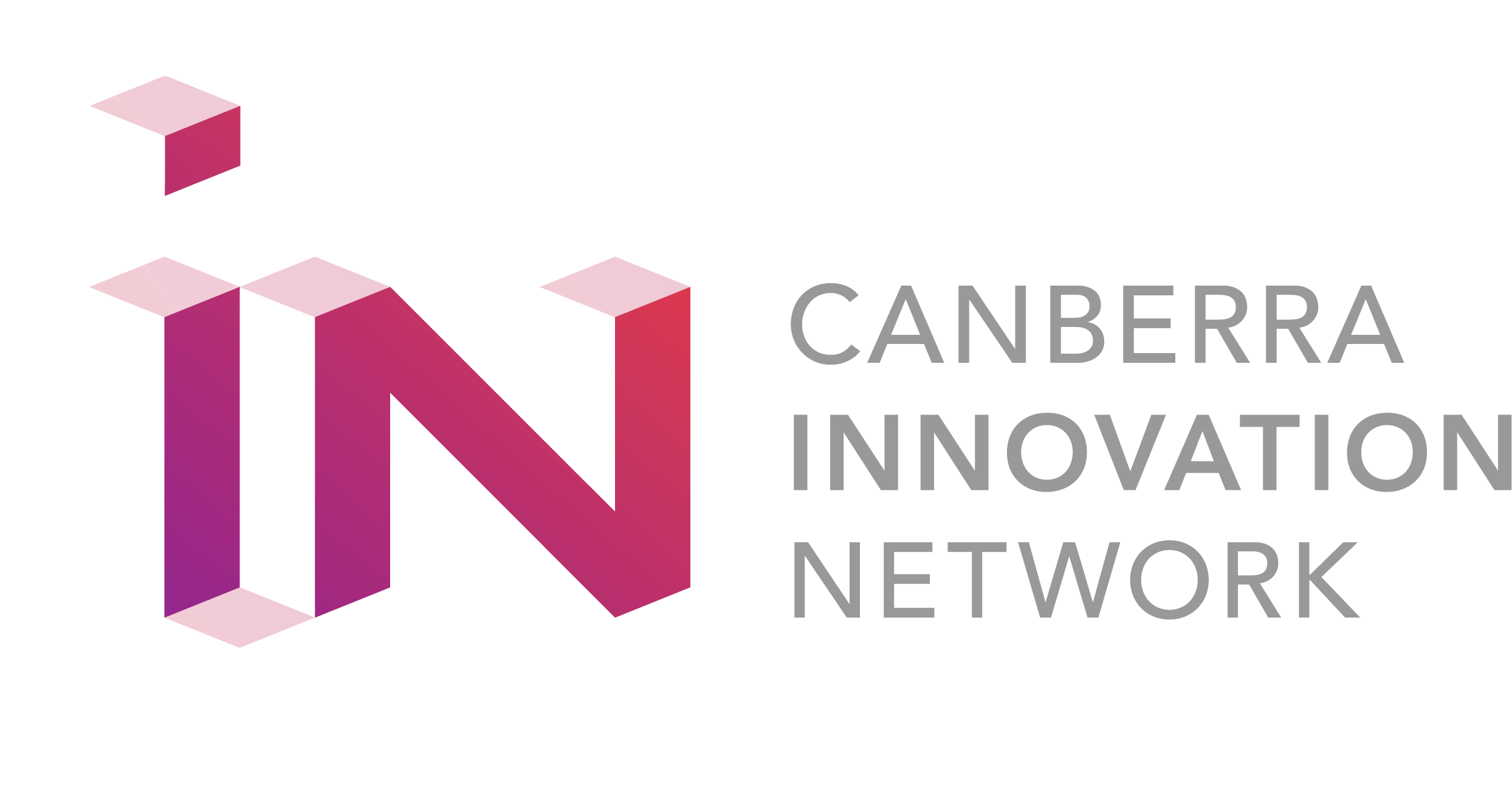- 26 October 2021
- Posted by: Canberra Innovation Network
- Categories: General News, Weekly Innovation Challenge

As part of the Canberra Innovation Network’s commitment to supporting our community of entrepreneurs during the ACT lockdown, we’ve reinstated our popular Weekly Innovation Challenge. The Weekly Innovation Challenge is for every entrepreneur, founder and business leader. If you’re growing a business, developing a product or just want to change the world, our goal is to show you relevant new ideas and challenge you to rapidly try them out. We introduce a topic, host guest experts, allow room for questions and end by setting a useful, actionable challenge for you to work on.
In the ninth and final instalment of the Weekly Innovation Challenge we hosted Stella Xu and Tim Hirst who discussed what you can do from the very beginning to ensure your company is set up to succeed. A big thank you to everyone who participated, and be sure to check out the catalogue of videos from this lockdown period in the links at the bottom of this article. Though the advice was given during a shutdown of business-as-we-knew-it, the tips are timeless and enthusiasm evergreen.
NB: Below we share notes taken from the live meeting. This is not a transcript and these are not direct quotes.
Welcome to #9 of our Weekly Innovation Challenge series! These one-hour webinars are meant to help take you outside of your day-to-day while giving you some fresh thinking and support.
We were so lucky to close out this series with the tremendously talented and connected Stella Xu and Tim Hirst, and we talked about steps you can take to set your startup off to succeed from the beginning.
Stella Xu: Stella is a Senior Associate at Main Sequence Ventures and specialises in deep tech investing.
Tim Hirst: Tim is a chairman, director and investor in a range of innovative technology companies.
What’s one thing you wish founders would pay more attention to as they prepare for growth?
Stella: I’ve learned your responsibility as CEO is NOT to do everything. Your job is to hire people better than you to do those things, and then keep abreast of the vision. That’s how you get your company into growth mode. So work on a hiring budget and write job descriptions that take into account your culture and how you expect team members to work with one another. One great experience I had was working at a company that would pair each new hire with someone who had been around for awhile, from another department, to meet for regular coffees and talk company culture.
Tim: From Day One, think of yourself as a global company and have a global mindset. Tap into expertise around the world and be open to an international perspective. Also? Don’t run out of money. So think hard about your investment thesis and how you’re going to raise money, and realise if you can raise more than that you should … because problems will arise.
When should I start building a team?
Before you start anything else! Tim had a board before he had a product. You need to build a team around a concept and idea, then capitalise it. So from the offset you have talent and dedication. The CEO is a supreme project manager, looking after the team but also all of the relationships in the web. Stella says ‘if someone can do one thing 60% as well as you (or better), the CEO, get them to do it’. Get used to things getting done not exactly how you would do them if you’d done them yourself early on. Invest forward. And know that things will change in the context of where the company is. So you want a culture that recognises changes.
It’s like playing chess — know your move three moves ahead. Five year plans are a thing for a reason. You need people with vision who can then execute. The biggest challenge isn’t coming up with the idea, it’s executing the idea.
What else do you emphasize focusing on early?
Get ahead of the curve and make sure your financial statements are top notch. That way in three years’ time you’re already set up. Board meetings and minutes can be structured as if you’re a multinational so that when you ARE a multinational company you’re ready.
Plan for performance reviews — it becomes difficult to keep people in line when you’re no longer all sitting together at the same table for lunch. This will help with retention AND alignment of values.
As you grow, communication will become more challenging. And as you grow, keep abreast of competitive salaries in your market. It can be worth taking independent advice on this.
Some helpful definitions, and a link:
Stella’s company encourages share-sharing with a team. Tim thinks a split between cash and options is a good way to align growth with long term value.
What about contractors?
In the first 6-12mo of a company, it can sometimes be easier for EVERYONE to be a contractor! It only goes so far but you might not yet be ready to pay for full-time at the start.

What’s a clever, impactful thing you’ve seen a founder do recently?
- Tina McIntosh (GRIFFIN) came up with a treatment for chronic pain based on science and a program that worked for her. It had to go through multiple iterations AND markets (from $200 to $8000) to realise that going after insurers rather than patients was the way to go. Took a few years and a lot of dexterity, but got there in the end.
- A founder built all of the infrastructure for a platform, but realised the platform could not scale at huge volume. The CEO and CTO argued about it. They started from scratch after a year or two, because they had a lot of trust in one another and dedication to the original goal. Things won’t always work out the way you want (around tech, products, market), but cherish the people who share your vision.
Picking the right investors is more important than getting investment early.
And ALWAYS be in the fundraising mode, speaking to investors.

It’s 90% perspiration, and the first three or four years will be hugely challenging, but also hugely rewarding. And the community is so supportive. Build your network! We wish you every success! 2% done – keep that mentality. Things don’t stop when you hit a certain benchmark — there will be another one! And if you enjoy the journey every day and continue to grow you’ll know you’re on the right path!
Previous Weekly Challenges:
Week 8: If I’ve received a grant, how am I going to amplify it? If I’m looking for a grant, how am I going to get my application to the top of the pile (with the knowlege that ICON grants close in less than two weeks!)?
Week 7: Do I have the right mentors to bring my innovation to life? What do I hope to gain from each mentor relationship and how am I going to drive things in that direction?
Week 6: What’s something I can take away from this conversation and bring to my team? How can I better understand the humanity they bring to my organisation? Go back to your team, imagine Renee sitting next to you, and think about what you’d say or ask to make everyone feel safe, heard and understood?
Week 5: What can I do for my business to improve my money management? That might be downloading some software or having a convo with my accountant …
Week 4: Have a hard look at what you can offer a potential investor and decide if you’re ready, or need to do some more work first. Once you’re ready put together a dream list of a half-dozen investors and practice your pitch on a mirror and on your lockdown bubble.
Week 3: Sign up for one of the free trials mentioned above and test it out on your site. If you’re averse to that, identify a friend who isn’t familiar with your site and give them the five-second-challenge, then implement a change you learn is necessary from what they spot.
Week 2: Identify the ONE thing you can do better for your customers, and just bloody do it!
Week 1: Realise one problem I have and share it with someone I trust (“I’m not sure what to do about XYZ” or “I’m worried about ABC”). Saying it out loud is sometimes all I need to do! But other times the input from my team, a friend or another member of the innovation community with an understanding of my industry is just what I need to solve this.

